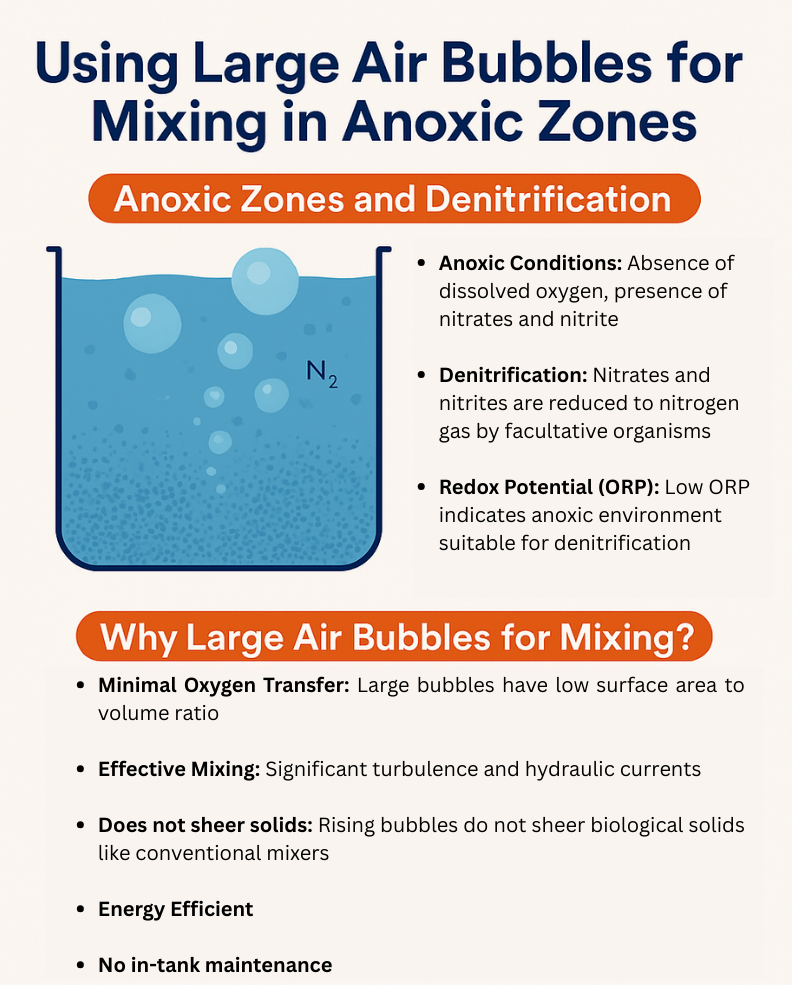
Using large air bubbles to mix activated sludge in an anoxic zone while maintaining low redox (oxidation-reduction potential) is a strategy employed in wastewater treatment to achieve denitrification. Here’s a breakdown of why this approach is effective:
Understanding Anoxic Zones and Denitrification
- Anoxic Condition: An anoxic environment in activated sludge is characterized by the absence of free dissolved oxygen (O2), but the presence of “bound” oxygen in compounds like nitrates (NO3−) and nitrites (NO2−).
- Denitrification: In this oxygen-deficient environment, facultative bacteria (denitrifiers) switch from using dissolved oxygen as their electron acceptor to using nitrates and nitrites. This biochemical process reduces nitrates and nitrites to nitrogen gas (N2), which then bubbles out of the water, thus removing nitrogen from the wastewater. This is a crucial step in preventing nutrient pollution in receiving water bodies.
- Redox Potential (ORP): ORP is a key indicator for controlling anoxic zones. Lower ORP values (generally below +50 mV, often even negative) indicate an anoxic condition suitable for denitrification. If DO is present, the ORP will be higher, indicating an aerobic environment, which inhibits denitrification.
Why Large Air Bubbles for Mixing in Anoxic Zones?
The primary challenge in anoxic zones is to provide sufficient mixing to keep the activated sludge in suspension and ensure good contact between the bacteria, wastewater, and nitrates, without introducing significant amounts of dissolved oxygen.
Large air bubbles address this challenge:
- Minimal Oxygen Transfer: Unlike fine bubbles used for aeration, large air bubbles have a much lower surface area-to-volume ratio. This significantly reduces the rate of oxygen transfer from the bubbles into the liquid. As they rise quickly through the water column, they don’t provide sufficient contact time for substantial oxygen dissolution.
- Effective Mixing: Despite minimal oxygen transfer, large bubbles create significant turbulence and hydraulic currents as they rise. This provides the necessary mixing action to:
- Keep biomass (activated sludge) suspended, preventing settling and dead zones.
- Ensure uniform distribution of the mixed liquor.
- Promote contact between the denitrifying bacteria and the nitrates/nitrites in the wastewater.
- Facilitate the release of nitrogen gas bubbles from the floc.
- Energy Efficiency (in some systems): Some systems utilizing large, compressed air bubbles for mixing claim to be more energy-efficient than traditional mechanical mixers, especially for larger tanks, due to the high volume of water moved with less power.
- No Mechanical Components in Water: Certain large bubble mixing systems operate by injecting air from outside the tank, meaning there are no mechanical or electrical components submerged in the wastewater. This can reduce maintenance requirements and potential for clogging.
Maintaining Redox in the Anoxic Zone
The success of using large air bubbles for mixing in anoxic zones hinges on carefully controlling the factors that influence redox:
- Absence of Free Oxygen: The fundamental principle is to prevent the introduction of free oxygen. The low oxygen transfer characteristic of large bubbles is central to this.
- Nitrate Availability: Denitrification requires sufficient nitrates to act as electron acceptors. These nitrates typically come from the aerobic zone via internal recycle of mixed liquor.
- Carbon Source (BOD): Heterotrophic denitrifying bacteria need an adequate carbon source (BOD) for their metabolic processes. Ensuring enough readily biodegradable organic matter is available in the anoxic zone is crucial.
- ORP Monitoring and Control: Real-time ORP monitoring is vital. It allows operators to confirm that anoxic conditions are maintained. If the ORP rises too high, it indicates oxygen intrusion, and adjustments can be made (e.g., reducing mixing intensity if it’s causing too much surface aeration, or checking for unintended oxygen sources). Some advanced systems use ORP to control mixing cycles, ensuring optimal anoxic conditions.
- Intermittent Aeration (in some configurations): In systems that combine aerobic and anoxic phases in a single reactor (like Sequencing Batch Reactors or intermittent aeration systems), large bubbles might be used for mixing during the anoxic phase, and then fine bubbles introduced for aeration during the aerobic phase. The control system would carefully manage the on/off cycles of aeration to ensure distinct anoxic periods with appropriate redox.
In summary, using large air bubbles for mixing in anoxic zones of activated sludge systems is a targeted approach that provides the necessary agitation to maintain solids suspension and promote biological activity for denitrification, while simultaneously minimizing the introduction of dissolved oxygen, thus preserving the crucial low-redox environment.

Dear Erik,
Could you please send me more information about cylinders (dimensions, volume, material) shown in the first photo and activated sludge properties (concentration) used in your
Settling Tests (SV30) – Procedure & Interpreting Results 8/12/2014?
Kind regards,
Richard (Ryszard) Blazejewski
Poznan University of Life Sciences, Poland
professor – emeritus
I apologize for the delay in responding to your question. The photo was from old training materials, so I am not sure of the actual materials used. Official settleometers are plastic with 2L volume – this come from work done over 50 years ago. Often, I see 1L graduated plastic cyliners being used. This tends to skew tests results higher than a standard 2L setup. My key point for the operators is to use the same method daily and do not switch protocols. If I can help with anyother questions, just send me an email erumbaugh@asterbio.com